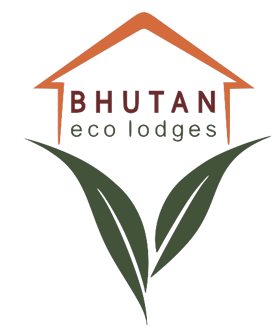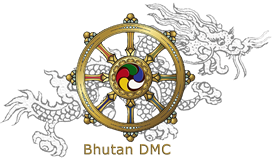Thimphu (altitude 2,320m) – A stronghold of traditional Bhutanese art, architecture and culture and the capital city of Bhutan
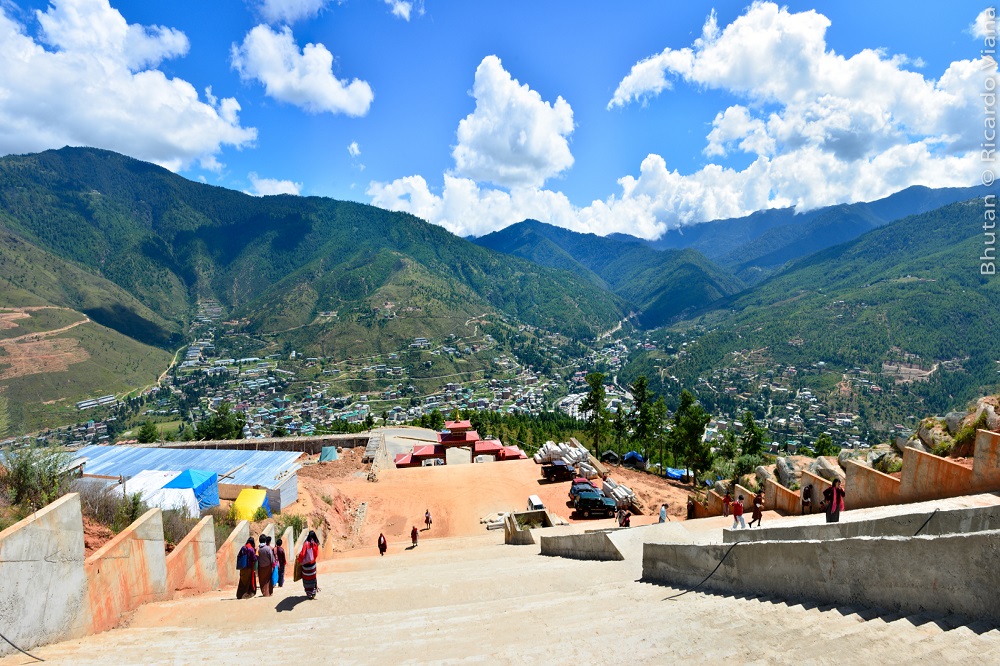
Nestled amid graceful pine covered hills on the western slopes of the Wang Chhu river valley, lies the thriving city of Thimphu, proud capital of Bhutan since 1955. It is a fascinating mix of ancient & modern and dominating the valley is the magnificent 13th century Trashichhoedzong Dzong, home of the National assembly and King’s Throne room. The city streets hum with business workers, resplendent in national dress ‘Kiras’ and ‘Ghos’, red-robed monks and farmers brining fresh produce to market from nearby villages and towns.
Places of Tourist Interest in Thimphu
Memorial Chorten
In the capital Thimphu, National memorial Chorten is an important landmark. Its history is recent, and its birth was result of a painful loss. In 1974, Her Majesty the Queen of 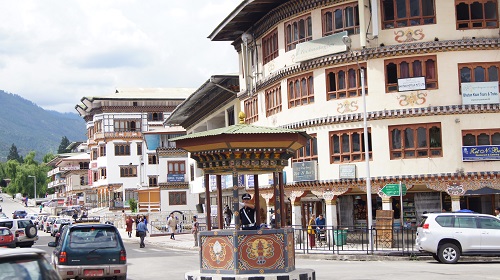 Second King built the chorten to pay homage to the memory of her royal son, His Majesty Jigme Dorji Wangchuk, the third King of Bhutan. It is therefore, arose out of profound grief to the royal family and to the people of Bhutan. Today, however the sanctity of its interior and the tranquillity of its surrounding offer respite and comfort to many. A befitting and beautiful tribute indeed.
Second King built the chorten to pay homage to the memory of her royal son, His Majesty Jigme Dorji Wangchuk, the third King of Bhutan. It is therefore, arose out of profound grief to the royal family and to the people of Bhutan. Today, however the sanctity of its interior and the tranquillity of its surrounding offer respite and comfort to many. A befitting and beautiful tribute indeed.
Simtokha Dzong
Five miles from Thimphu stands the 17th century Simtokha Dzong standing on a lofty ridge. Enthral yourself with the most noteworthy artistic feature in form of over 300 finely worked slate carvings behind the prayer wheels in the courtyard. Built in 1627 by Zhabdrung Ngawang Namgyal, this oldest Dzong in the country, now houses the School for Buddhist studies, a unique institution dedicated to the preservation and study of Bhutanese culture. The Simtokha Rigzhung Institute was established in 1961, and since then its reputation as a center for language and cultural studies has been known throughout Bhutan.
Trashichhodzong
Also known as ‘fortress of the glorious religion’, it was initially built in 1641 and later restored in its present form by King Jigme Dorji Wangchuk in 1965. The Dzong houses, main secretariat building which houses the throne room of His Majesty, the King of Bhutan. The National Assembly Hall is housed in a modern building on the other side of the river from the Dzong. During the warmer summer months, the monk body headed by His Holiness, the Je Khenpo, makes its home in the Dzong.
National Library
The National Library was established in 1967 and later merged with National Commission for Cultural Affairs in 1985. Its wider goal and functions include: (i) Collection and preservation of ancient Bhutanese literature on religion, cultural, history & social traditions, (ii) Provision of facilities for research and other academic pursuits, (iii) Preservation of old and rare books & manuscripts, (iv) Preservation of traditional xylographic blocks, (v) Research and documentation of literary works and stories inherited through traditional and oral communication methods, (vi) Promotion and publishing of literary works on traditional and contemporary themes. The Library is also known for housing the world’s largest book.
Institute of Zorig Chusum or Arts & crafts School
The Institute of Zorig Chosum is the premier institution of traditional arts and crafts set up by the Royal Government of Bhutan in 1971, with two objectives – to preserve traditional arts and crafts and to create job opportunities for the youth of the country. Bhutan group traditional arts and handicrafts under one heading, Zorig Chusum – ‘the thirteen arts’ (‘zo’ means to ‘make’, ‘rig’ – ‘science’ and ‘chusum’ – ‘thirteen’). The most sought-after studies in the institute are painting and sculpture. On a visit, one can see students at work practicing various traditional arts & crafts.
Textile Museum
Bhutanese textiles are an integral part of its cultural and heritage and are unique for their diversity and sophistication. Textile Museum at Thimphu has given a new platform to the nation’s textiles and Bhutanese weavers and boasts of an invaluable collection of antique textile artifacts of Bhutan. The museum has opened its exhibition on six major themes - warp pattern weaves, weft pattern weaves, role of textiles in religion, achievements in textile arts, textiles from indigenous fibres and the royal collection.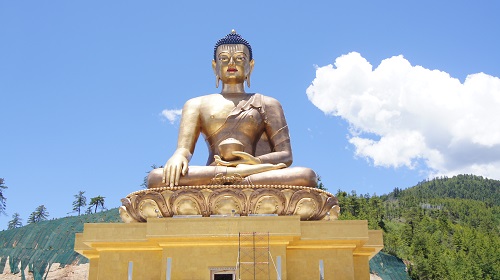
Folk Heritage Museum
The Folk Heritage Museum dedicated to connecting people with the rich Bhutanese Folk heritage and rural history through exhibits, demonstrations, educational programs and documentation of Bhutanese rural life. The museum strives to disseminate the rich cultural heritage across generations by preserving it in different forms. Visit to the Folk Heritage Museum is a unique experience and the principal exhibit of the museum itself is a restored three –storied, traditional rammed mud and the timber house dating back to the mid-19th century.
Traditional Medicine Institute
The healthcare system in Bhutan comprises of both modern and traditional medical systems, which are integrated to maximize public healthcare services. Traditional Medicine Institute was established with objective to promote and preserve the traditional medical systems of the country those are based on a rich cultural experience, and to complement biomedicine. The Institute started as Indigenous Medicine Unit and later formally recognised by the Royal Government in 1967 and then its development as a modernised system within the Bhutanese public health system began. In 1979 the Unit was upgraded to become the National Institute of Traditional Medicine Services. Since 1998 the Institute has been upgraded as the Institute of Traditional Medicine Service with its three arms: the national traditional medicine hospital, the national institute of traditional medicine, and the pharmaceutical and research unit.
Simply Bhutan
Simply Bhutan is an exclusive project under the Bhutan Youth Development Fund, built to offer a unique experience to its visitors. It is a living museum and studio encapsulating the rich cultural heritage of the Bhutanese people. Here the serene and picturesque little village house has been recreated using doors and windows and other building materials from old traditional houses that were demolished, the studio portrays age-old life styles of the Bhutanese people. Many of the items on display date back to the days gone by.
Changangkha Lhakhang
One of the ancient temples located on a ridge above Thimphu, Changangkha Lhakhang was established on a site chosen by Lama Phajo Drugom Shigpo, who came from Tibet and regarded as the founder of Drukpa lineage in Bhutan. The temple was laid in 12th century while the work of which was extended by his son in the 13th century. The central statue here is Chenrezig in a manifestation with 11 heads. For centuries, parents come here for blessing of their new-borns from the protector deity Tamdrin and children are blessed by a phurba (ritual dagger) and given a sacred thread. From temple courtyard, there is fascinating view of Thimphu valley.
Buddha Dordenma
The Buddha Dordenma is located atop a hill in Kuenselphodrang Nature Park and overlooks the Southern entrance to Thimphu Valley. The statue fulfils an ancient prophecy dating back to the 8th century A.D that was discovered by Terton Pema Lingpa (Religious Treasure Discoverer) and is said to emanate an aura of peace and happiness to the entire world. This massive statue of Shakyamuni made of bronze and is gilded in gold, measures 51.5 meters in height, making it one of the largest statues, in Bhutan. 125,000 smaller Buddha statues have been placed within the Buddha Dordenma statue, each of these also have been cast in bronze and gilded. The throne that the Buddha Dordenma sits upon is a large meditation hall..
Handicrafts Emporium
Though there are various Handicrafts Emporiums in town but established in 1971 as a state handicraft store, this Emporium today is one of the best and authentic outlets in Thimphu to buy Bhutanese souvenirs including finely made traditional clothes, jewellery, linen work, books, and paintings. From 1992, it is under management of National Women’s Association of Bhutan.
Takin Preserve
Popularly known as Motithang Zoo, the preserve houses takin, the national animal of Bhutan. It is an extremely rare bovid mammal of the ovine-carpine family. Apart from takin, this about 8-acre enclosure is also home to sambars and barking deers rescued from different parts of the country.
Centenary Farmers’ Market
One of the largest domestic market, it was built in 2008 to mark the coronation of fifth king of Bhutan and hundred years of monarchy. This two storied building has 458 stalls for the sale of vegetable, fruits, meat, farm products. Many stalls here also contain beautifully handcrafted items such as yak tail dusters, butter teacups and other attractive household items.
Sangaygang Viewpoint
This is site of the transmitter tower of the Bhutan Broadcasting Services (BBS), a fascinating viewpoint and in fact one of the best places for photographers. On clear days, the ubiquitous prayer flags fluttering on the hills in the distance as well as the whole of the Wang valley, captures the true moments of photographers.
Drubthob Goemba (Zilukha Nunnery)
Built in 1976 by the 16th emanation of Thangtong Gyalpo, Drubthob Rikey Jadrel, this is the only nunnery in the capital city of Thimphu. Located above Zilukha Lower Secondary School, overlooking Traschichhoedzong, the nunnery is home to about 60 nuns who lead life of spiritualism, prayer and meditation.
Handmade Paper Factory
Located about 1 km from Thimphu city centre, this factory uses bark of Daphne and Dhekap trees to produce traditional paper. Here, visitors can observe the entire process of producing handmade paper using ancient traditional methods that have been practiced for generations. Visitorscan even try your hand at this ancient craft and make some paper of your very own as a souvenir.
Pangri Zampa
This monastery was built in 1529 by Lam Ngawang Chogyal who came to Bhutan from Ralung in Tibet. It was earlier known as Druk Phodrangding, ‘the Castle of the Dragon’, after the name of an important monastery in Tibet. Here is a monastic school where Buddhist monks learn Lamaism and astrology based on Buddhist philosophy.
Hikes and Excursions in and around Thimphu
Tango Goemba
This monastery was founded by Lama gyalwa Lhanangpa in the 12th century and the present building was constructed in the 15th century by popular saint, Lama Drukpa Kuenley also known as Divine Madman. In 1616, Zhabdrung Ngawang Namgyal visited Tango and meditated in a cave near the monastery. His meditation helped ensure the defeat of an invading Tibetan army. The head Lama, a descendent of Lama Drukpa Kuenley presented the goemba to Zhabdrung, who carved a sandalwood statue of Chenrezig which he installed in the monastery. The picturesque three-storey tower of the monastery and the other surrounding buildings were built in the 18th century by the eighth Desi, Druk Rabgye and Shabdrung Jigme Chhogyel added the golden roof in the 19th century. Located 12 km north of Thimphu, it takes about one hour (one way walk) to reach here, gaining elevation of 300m.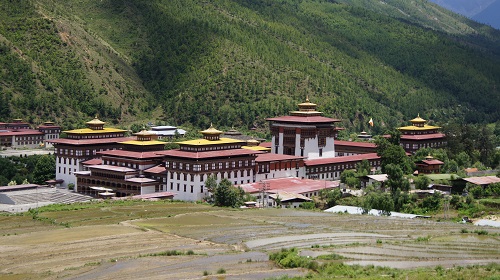
Cheri Goemba
Known as Cheri Dorji Dhen, this monastery was built in 1620 by Zhabdrung Ngawang Namgyal who was the first ruler of unified Bhutan. The first order of monks from the Tibetan School of Drukpa Kagyupa version of Buddhism was established in Bhutan at this Gompa. Today, the monastery is an important seat of religious teaching that attracts monks from around the country who come for refresher courses and spiritual retreats. At about one and a half hour walk from Dodena (alt. 2,600m), to reach here, the trail commences by crossing a lovely, covered bridge that spans the Thimphu Chhu river and then climbs steeply to the monastery.
Phajoding Goemba
Built in 15th century, by Shagcha Rinchen who introduced the Drukpa Kagyupa school in Bhutan, in the 13th century, it was one time one of the richest monasteries in the country. The Phajoding monastery is still considered to be one of the oldest and decorated monasteries in the country, and a major meditation site for pilgrims and practioners of the Buddhist faith. Nestled in the hills, overlooking the capital city of Thimphu, the trek to Phajoding is about 5 km uphill walk through mostly pine forests and rewarded by excellent views from the top.
Druk Wangyal Chortens
Located at Dochula pass (3,080m) along the Thimphu-Punakha highway, it’s a cluster of 108 stupas built by the Queen Mother Her Majesty Ashi Dorji Wangmo Wangchuk as a tribute to Fourth King for his selfless service and visionary leadership. It represents a symbol of appreciation, loyalty, dedication and love that touches the nation and blesses its people.
Vividly portraying Bhutan’s spiritual and artistic traditions, the chortens sit astride a strategic mound that offers a magnificent view of the endless ridges that roll into the distant majestic snow-capped peaks in the north. Each chorten is carefully crafted out of wood and stone with the proportion dictated by the ancient legacy of Bhutanese artwork. They are proportionately sized to complement the sacred nye of Dochula.
Druk Wangyal Lhakhang
Majestically situated on Dochula pass, The Druk Wangyal Lhakhang (temple) is built in honour of His Majesty the fourth Druk Gyalpo Jigme Singye Wangchuck. The past and future appear to merge in the details of the lhakhang (temple) and its structure tells the story of a supreme warrior figure, whose vision pierces the distant future in a fine blend of history and mythology. The scenery from the Druk Wangyal Lhakhang is stunning with 360-degree panoramic view of Himalayan Mountainrange. The view is especially scenic on clear, winter days with snow-capped mountains forming a majestic backdrop to the tranquillity of the 108 chortens gracing the Dochula pass.
.
HOTELS IN THIMPHU
HOTELS IN PUNAKHA & WANGDUE
HOTELS IN GANGTEY
HOTELS IN TRONGSA
HOTELS IN BUMTHANG
HOTELS IN MONGAR
HOTELS IN TRASHIGANG
HOTELS IN SAMDRUP JONGKHAR
HOTELS IN PHUENTSHOLING
HOTELS IN HAA
HOTELS IN GELEPHU
HOTELS IN ZHEMGANG
RESTAURANTS IN PARO
RESTAURANTS IN THIMPHU
RESTAURANTS IN PUNAKHA
TOUR ITINERARIES
TREKKING ITINERARIES
SPECIAL INTERESTS TOURS
UNIQUE FESTIVALS & FAIRS
BLOG

